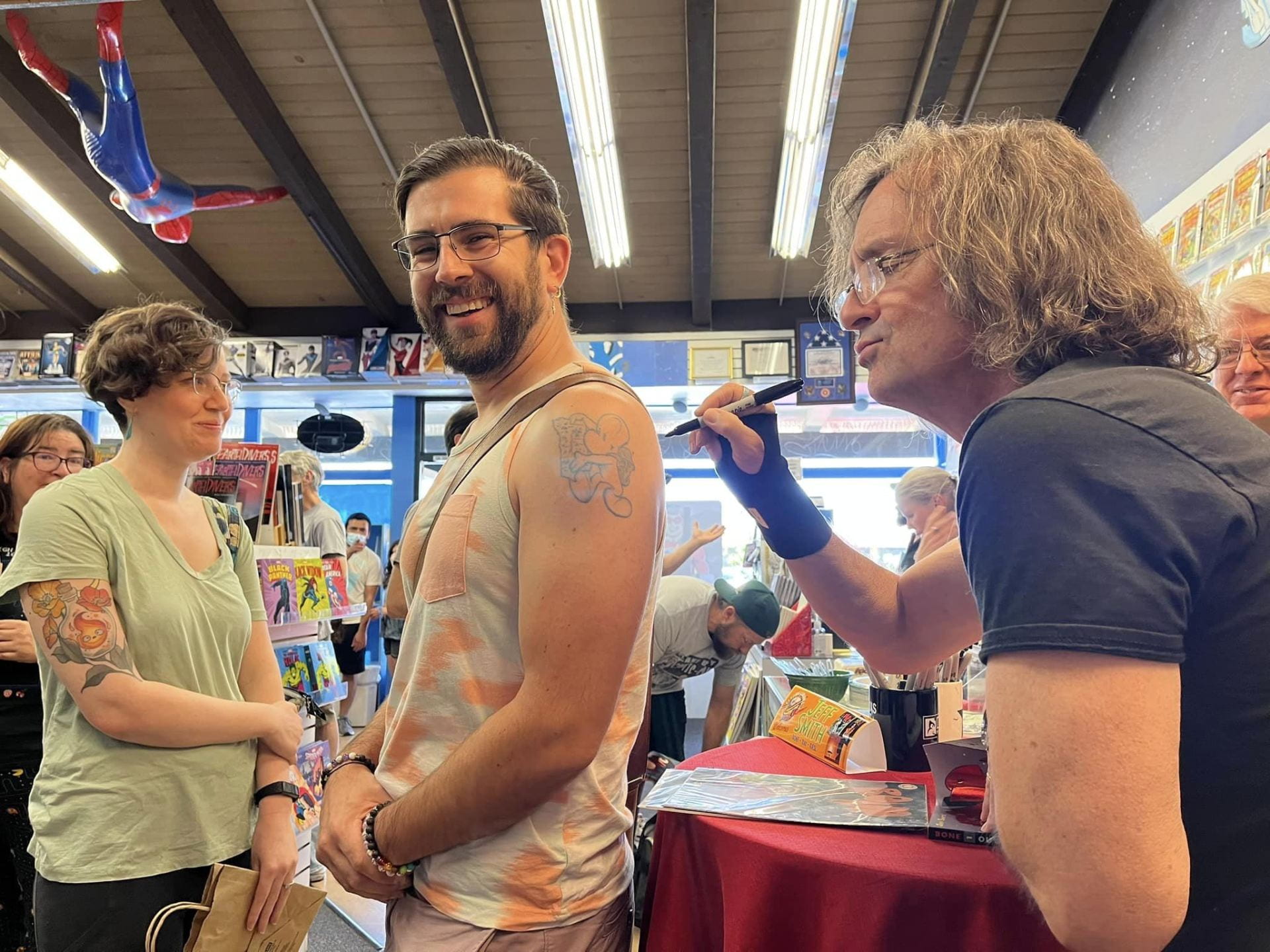
Jeff Smith (right) singing a fan’s tattoo of Fone Bone, the main character of Smith’s “BONE” series, during a book signing on his “Dawn of Man” National Tour in April. Credit: Courtesy of Kathleen Glosan
As a high school senior, Jeff Smith’s passion for comics was as strong as when he was a mere 4 years old reading the Sunday morning cartoons with his dad at the kitchen table.
With the daunting task of choosing a career inching nearer and nearer as high school graduation loomed over him, Smith informed his favorite art teacher — notably, the only one with whom he didn’t have a “combative relationship” — he was considering applying to a graphic arts position at one of the largest companies in the world.
“I’m thinking about putting in an application to Disney,” Smith said.
The room went still.
“You would never make it at Disney.”
Self-doubt flooded Smith’s mind and panic set in. But his teacher quickly clarified that his comment wasn’t a poor evaluation of Smith’s talent, it was quite the opposite; he thought Smith’s imagination would be stifled in such a bureaucratic corporation.
He successfully talked Smith out of applying.
“And bless him,” Smith said. “Because my life turned out so much better the way it did.”
Smith, now 63, has since fulfilled his childhood dream of becoming a successful cartoonist, widely known for his “BONE” comic book series. Inspired by characters he drew during his five years creating comic strips for The Lantern as an Ohio State student, Smith launched “THORN: The Complete Proto-BONE College Strips 1982-1986” Oct. 18 on Kickstarter, where fans can see the original designs that provoked Smith to create the popular “BONE” series.
However, success stories like these may not feel achievable for many artistic college students.
According to Data USA, 964,792 total health degrees were awarded in 2021, along with 860,674 degrees in business and 556,813 in liberal arts and sciences. For visual and performing arts degrees, that number drops to 149,047. E.J. Westlake, the Department of Theatre, Film, and Media Arts chair, said the contrast is likely due to utilitarian values in American culture, which have deemed the arts as unnecessary and unproductive.
“What people forget about studying the arts is that there are all of these transferable skills,” Westlake said. “On the one hand, you can make a career as an artist, and on the other hand, the things that you learn doing art end up being things that today’s corporations, today’s employers, really, really value.”
Laura Lisbon, the Department of Art chair and professor, agreed the skills developed in pursuing an arts degree are invaluable.
“It’s the truth that art stretches one’s mind toward problem-solving differently, opens a space for empathy and understanding other perspectives, all the things that we would hope our best leaders have,” Lisbon said. “Art is actually very central to creative inquiry, to thinking about communities, thinking about the world and the opportunity to do that at the university is so wonderful.”
Smith spent roughly four years bouncing around between jobs, trying everything from fast food to bookstores, until he finally set his sights on Ohio State, where he relished in the idea of creating comic strips for The Lantern as a way to practice his art.
It was here, in 1982, that Smith met Lucy Shelton Caswell, now professor emerita and founding curator of the Billy Ireland Cartoon Library & Museum.
On the first floor of the old journalism building, Smith stumbled across this museum — which he said at the time was called “the Graphic Arts Library or something like that” — and was introduced to Shelton Caswell, who allowed Smith to experience the professional world of cartoons for the first time.
“She had cultivated relationships with so many cartoonists,” Smith said. “I got to meet all those cartoonists because I was hanging around with Lucy Shelton Caswell.”
Since then, Smith and Shelton Caswell agree the resources for students interested in cartoons have expanded immensely, though they said the stigma surrounding arts-related careers has yet to dissipate.
Shelton Caswell said if there were more academic opportunities for students to explore the arts from an early age, they may realize they actually possess artistic talent.
“I think part of it is that we do not have generally very good arts education,” Shelton Caswell said. “And so we grow up thinking we can’t draw and ‘why would I major in art if I think I can’t draw?’”
Despite what the statistics may show, Smith said he encourages art-loving students to persevere and follow their passion, so long as they’re willing to put in the work.
“Don’t give up until you really try,” Smith said. “I had the idea that someone would spot my comic and I’d get a call from some syndicate editor, or maybe it would be just as simple as me sending it in and they would respond. No, I mean, really try it. Get out there.”
Smith said he and Shelton Caswell have collaborated to create the entry-level comics festival Cartoon Crossroads Columbus, now going on its 10th year, which he and Shelton Caswell agreed is a great opportunity to make professional connections and book publishing gigs.
“I think for young artists, young cartoonists to talk one-on-one and to hear the stories of people who have made it is a really important thing, and it’s one of the things we’ve tried to accomplish with Cartoon Crossroads Columbus,” Shelton Caswell said. “If you have the burning desire — and I mean seriously willing to sacrifice and take risks — then there is the possibility for success.”
More information about Cartoon Crossroads Columbus can be found on its website. “THORN: The Complete Proto-BONE College Strips 1982-1986” will be available on Kickstarter for crowdfunding until Nov. 17.


